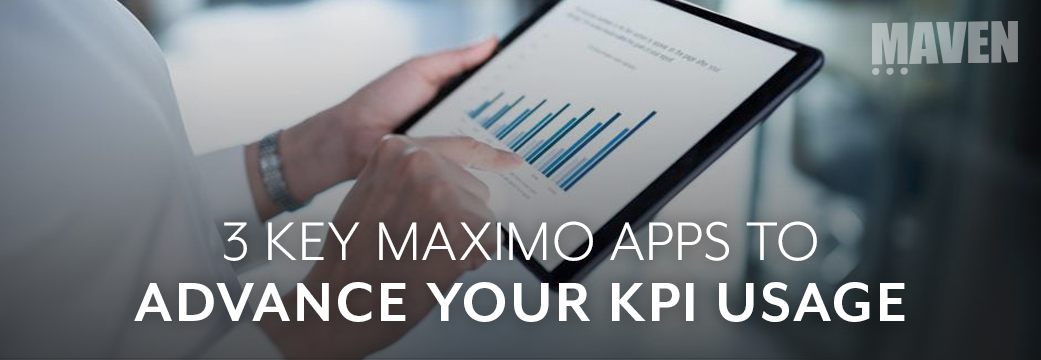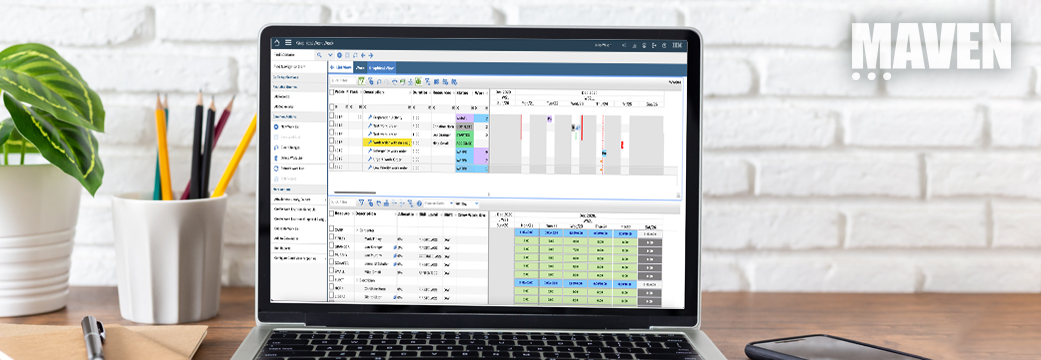Key Performance Indicators (KPIs) enable organizations to define, analyze, and monitor critical performance metrics. These metrics can span the core functionality of Maximo in its key areas of Asset, Work, and Inventory Management. Examples can include:
- Number of Asset Failures
- Percentage of Critical Assets missing Failure Codes (Spare Parts or Job Plans…)
- MTTR (Mean Time To Repair)
- MTBF (Mean Time Between Failures)
- Schedule Compliance
- Percentage of Reactive to Proactive Work
- Inventory Turns
- Inventory Stockouts
- Inactive Inventory
Targets for each of these metrics are set – and then continuous measurement values are taken to show degradation or progress towards the predefined goal.
Using Maximo to manage your KPIs efficiently and effectively is a critical step in advancing your Asset Management Journey. Enabling Performance Management through KPIs in Maximo are in three applications:
- KPI Template
- KPI Manager
- KPI Viewer
The first two applications target a Maximo Administrator or Maximo Business Analyst – who are familiar with the Maximo database, SQL queries, and setting security access. KPI Viewer, the third application, targets all Maximo users who view, monitor, and analyze performance metrics.

The numbers and types of KPIs will vary for each organization. Factors influencing an organization’s KPIs include its Business Needs, Regulatory Requirements, Asset Management Maturity, and many more factors. This article will not focus on what KPIs your organization should utilize, but it will highlight the Maximo applications/tools available to monitor your Asset Management Performance.
KPI Template Application
The KPI Template application streamlines the creation and maintenance of individual KPI records. Like the Asset Template application, it is best suited for use cases where multiple individual KPIs are required – which utilize the same SQL but have different variables.
This may be best explained with an example. Imagine your organization is focusing heavily on Data Quality and collecting critical failure information. Key to this is having failure codes defined on your assets.
You have been tasked to create KPIs on critical active assets with no Failure Codes. Critical assets are defined via their priority level where 1 is the highest priority. You could use:
KPI Manager: Create three individual KPI records by using the New Record or Duplicate functionality. However, if a change is required to these KPIs, you would have to manually update each individual KPI record – potentially leading to inconsistent information.
KPI Template: Create one KPI Template record and define three variable values for the asset priority. Three individual KPI records are then generated and linked to the original KPI Template record. If a SQL change is required the single KPI Template record is updated, and the individual records regenerated with the same SQL change consistently pushed out to each linked record.
The mechanics for adding a KPI Template record include three main components which are defined in this sequence:
- KPI Query: The first section of the KPI template includes header values (e.g., Description) and most importantly – the KPI SQL with one or more variables. The variable(s) are used to create multiple variations of the KPI.Continuing with our example, the Active Assets without Failure Codes KPI has one variable – priority. The variable must utilize the syntax ${variable} as highlighted below in red.
select count(assetnum) from asset
where status in (‘ACTIVE’,’OPERATING’, ‘BROKEN’)
and priority = ${priority}
and failurecode is nullThis unique variable syntax distinguishes KPI variables from other Maximo defined variables, including runtime variables – (&{RuntimeVariable}& – which can also be used within the KPI SQL.
- Variable Definition: Next, the variable(s) must be defined. The definition can bind the variable to a specific Maximo Object and Attribute name (e.g., ASSET.PRIORITY) or can be unbound variables, not related to a specific Maximo Object or Attribute (e.g., Business Unit).
- Variable Values: The third step is setting the individual values for the variables (In our example, 1, 2 and 3 priority assets) along with their KPI limits (values which determine its red/yellow/green KPI status).The fields used within the KPI Query section are noted below.

Generating Individual KPI Records
After creating the KPI template including its SQL, variables, and variable values – the individual KPIs will be generated. Generating the individual KPI records includes these key processes and relationships:
- The KPI Generation process includes a validation of the SQL query, including a check that at least one variable is defined in the query.
- After validation of the content, individual KPI records are created – adding them as KPIs in the KPI Manager application, with the relationship to the originating KPI Template.
- If the KPI is updated in the KPI manager application, it will remove the relationship to the KPI template.

KPI Manager Application
The KPI Manager traditionally was the single KPI application used by both Administrators to define KPIs and for Maximo Users to view KPI performance. Maximo 76 enhancements to the application clearly define its purpose for Administrators or Business Analysts to specify its calculations and measures and defines its security access, schedule run times, and exact definition.

Drilling deeper into a subset of the features in the KPI Manager application is first – Security. Many Corporate measures should be visible to all employees – including ‘Number of Safety Incidents’ or ‘Carbon Emission Reductions’. As Organizational KPIs they are top level, and frequently consistent of lower or child level of KPIs set at a division or departmental level – measured and accessed by a subset of individuals.
If we look deeper at the ‘Number of Safety Incidents’ for example, there are many factors that impact that measure including:
- Accurate safety procedures
- Trained and qualified employees
- Functioning and available safety equipment
- Properly maintained assets
Each of these lower-level KPIs are very important to the organization but because only specific departmental roles directly impact the KPI’s performance (e.g., accurate safety procedures) – only those specific departmental roles may require access to them. Maximo’s KPI Manager enables varying levels of KPI security that your organization needs from providing public security access to individual security group access.

Another critical feature set of the KPI Manager application is scheduling. KPI scheduling stores the specific KPI value at a point in time and the values are then used for KPI trending to see if performance is improving or degrading over time. Like security where all KPIs do not need to be accessed by all individuals – all KPIs do not need to be run on the same schedule. KPIs for ‘Overdue Work’ may need to be run each day – while KPIs for ‘Assets without Failure Codes’ may only need to be run once a week or once a month.
Using the KPICronTASK, your Administrator can set up any number of schedule times in the Cron Task application – from each Monday at 6am to the first day of the month at 3am. These scheduled times are then selectable for each KPI from the KPI Manager Set Schedule action.

KPI Viewer
Rounding out the portfolio of Maximo’s KPI applications is the KPI Viewer application. This application is intended for all Maximo user roles. It is available to users when they need more details than the Start Center KPI information displays – including the KPI trends, comparisons to related KPIs, and very importantly – the KPI definition.
Looking at the KPI description below ‘Active Assets without Failure Code: Priority 1 Assets’ this title conveys information on what the KPI is measuring, but is it enough? What is an active asset? Is an active asset an operational asset, and if so, defines that? What defines operating? Is that a status? Are assets active if they are spares or rotating assets? Clearly defining what a KPI is, its importance to the organization, and what the organization’s KPI specific goals are key to organizational buy-in and understanding.
Detailed KPI information is entered in the KPI’s Long Description field in KPI Manager. It then displays to the user reviewing the information in the KPI Viewer application as shown below.

Also of note is the log functionality of KPI Viewer. The log functionality enables historical record keeping of communication on individual KPIs. This can be critically important if you are tracking the changing definition, limits, or goals of a KPI – or if your users want to raise questions or concerns with KPIs.
Conclusion
Maximo’s KPI Applications – KPI Template, KPI Manager, and KPI Viewer offer enterprise feature sets in defining, maintaining, securing, viewing, and analyzing Asset Management measures for your organization. Maven Asset Management invites you to explore these features in more depth by viewing our suite of Maximo KPI videos here or contacting us at MAS@MavenAsset.com.







